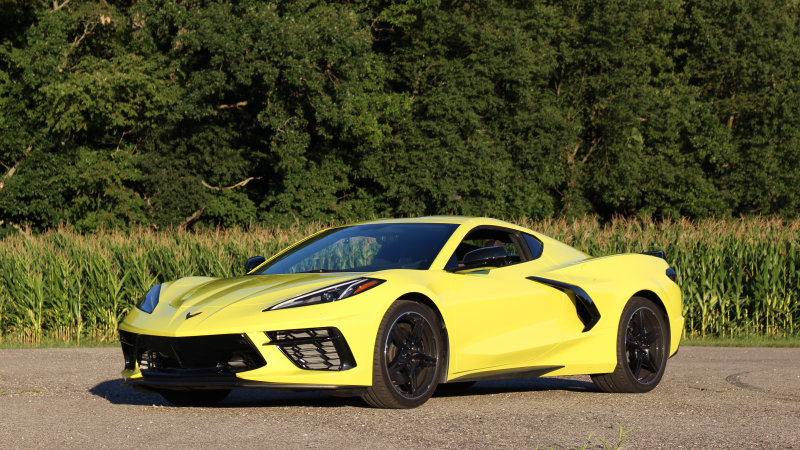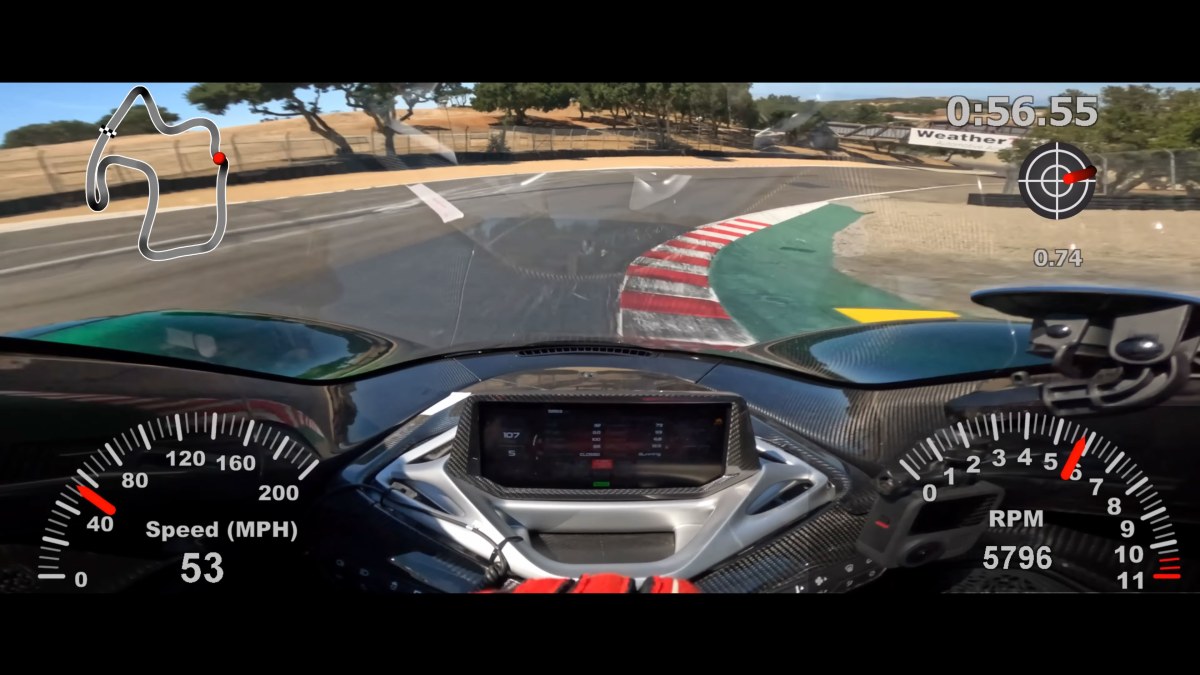The $59,995 2020 Chevrolet Corvette exists. This one isn’t it. Chevy sent me the complete opposite of a base Corvette, as the sticker on this Accelerate Yellow 3LT model came to $86,860. Yet, after a week in the tight bucket seat, I’m convinced it’s still a bargain.
Raw performance, sophistication, luxury, price. Pick three, because combining all four of these elements in a sports car or supercar is like trying to find Waldo when he’s been torn out of the page. Chevy is turning this conundrum upside down with the new Corvette. Equipped properly, the C8 checks all four of the boxes emphatically.
Performance is a no-doubter. The 6.2-liter V8 makes 495 horsepower and 470 pound-feet of torque in this Z51 pack car, rocketing it to 60 mph in just 2.9 seconds via an excellent launch control system. The magnetic dampers make for a sophisticated ride and handling balance. It can go from forgiving and plush to racetrack stiff at the twist of a dial. The interior is more luxurious and tech heavy than anything else GM makes, save for a loaded-up Cadillac. And then there’s the price. How Chevy priced this car below $100,000 still baffles me. Almost nothing is missing, but let’s dive in a bit deeper, starting from the best place to be: the driver’s seat.
Reaching beyond the highly-bolstered suede, leather and mesh Competition GT3 seats in this C8, everything I touch feels of quality. Yellow accents are splashed about the interior in thoughtful locations. Even the removable roof has yellow stitching woven in. Before I even get on the road, this attention to detail and level of customization reminds me of Porsche — the Chevy options are just cheaper. The spectacular view forward over a low nose keeps the Porsche theme on track, but it trails off when I begin to take in the interior design language around me.
No car takes the jet fighter cockpit theme as seriously as the Corvette does. I’m cocooned in my own bubble, completely walled-off from the passenger, and the passenger from me. Wide, swooping armrests are swathed in suede and placed at perfect elbow-resting height. The square-shaped suede-covered ($595) steering wheel isn’t weird to use, but spokes at 9 and 3 would be preferable over their current 8:30 and 3:30 positions. My passengers kept accidentally adjusting my seat and temperature controls on the vertical climate control stack (driver on top, passenger on bottom), but I became accustomed to the design quickly. It beats putting the climate controls in a touchscreen. There’s a general feeling of busyness inside with all the sharp angles and its multi-tiered dash design. GM may be trying a little too hard to make it exotic, but functionality doesn’t suffer for the styling, so I accept the flair.
The push-to-start button presses in with a satisfying click, but even more satisfying than that is tapping the remote start on the keyfob when standing near the loud pipes. Since the Corvette saves its drive mode from the last engine cycle, you can remote start your engine with the exhaust in Track mode (thank you to the engineers who did this). It is thunderous and guttural and all the things you want the startup to be.
The drive mode dial has proper heft, and the digital instrument cluster quickly animates through layouts with each new mode. Ergonomically, the interior is brilliant. My seating position is spot on with the seat set to its lowest point. Being able to see out the back with a standard mirror would be nice, but the digital rearview camera mirror on this car is a revelation for a mid-engine layout. You can see everything, and glare from taller cars’ headlights in the dark is a non-issue — even the driver-side mirror is auto-dimming. All this, and my butt and back are cool via the ventilated seats.
Setting out in Tour (comfort) mode, GM’s Small Block LT2 clacks away quietly behind my ear, sounding every bit like a Camaro or the previous Corvette. A thick piece of glass separates the cabin from the engine bay, allowing driver and passenger to look back at the pretty V8. It’s far more sedate and normal to cruise around in than you might imagine. The steering wheel flies left or right with ease at low speeds, the brakes are comfortable but not touchy, and those magnetic dampers are damping out the bumps. The big engine and eight-speed dual-clutch gearbox never fully fade into the background when casually driving around, but there’s no drama at low speeds. Ferraris or Lamborghinis never stop telling you what they are when cruising through town. If it weren’t for the incessant staring and pointing, I could’ve forgotten I was driving the hottest, most-anticipated car of the last several years. Credit to Chevy for making this beast so livable on a day-to-day basis.
Not to say the Corvette is quiet inside (it’s not), but that level of refinement in the cabin in casual driving isn’t always conducive to noise and personality when the right pedal is flat. Even with the supplemental exhaust noise being pumped into the cabin via the speakers, the Corvette isn’t as loud inside as I imagined it would’ve been with the performance exhaust. It’s opposite what’s going on out back, too. This Corvette sounds like NASCAR thunder from the roadside as it pounds through the forest, barking and snapping at each quick gear change. Problem is, the driver is only getting a fraction of this in their eardrums. I have a certain expectation for theater and aural wonder from a mid-engine car. The Corvette could use a tinge more of both.
Now, enough with the nit-picking. Power (so much of it) is simply here. It’s like a light switch. The speed at which this updated V8 revs — get the full download in our First Drive — is one pivotal aspect that stands out. Whether you’re banging through first and second or free revving for a demanding onlooker, it goes from idle to 6,500 rpm (redline) in a flash. The steady increase in shove keeps coming all the way to the top despite peak torque hitting at 5,150 rpm.
There isn’t much fuss in the power band. Everything is business as usual if you’re accustomed to GM’s Small Block V8. It’s glorious in its simplicity, and brings a sense of normalcy to the gob smacking acceleration. I’m not wanting for any more forward thrust — there is zero letup at legal speeds — but I’m already looking forward to the shriek of the flat-plane crank Corvette headed our way soon. This engine is an ode to the traditionalists, but the flat-plane crank ‘Vette will be an ode to people like me who love high-revving, exotic engines.
Once I make it out to some proper driving roads, the brilliance of this chassis comes into plain view. It doesn’t feel like a company’s first go at a mid-engine supercar. No, it’s well-tuned and strikes a wonderful ride and handling balance the likes of which Porsche has been perfecting for years with the 911. The magnetic dampers on this car deserve many thank you notes. Turn-in is crisp and quick. The nose is happy to be pointed in a different direction at a moment’s notice, and there’s zero uneasiness coming from the rear end. As the Gs build, the Corvette remains a wonderfully balanced rock. I’m waiting for the rear end to step out on me as I apply more and more throttle coming out of turns, but it wriggles, then sticks with the weight of the engine keeping it planted. This car will happily go sideways if you intentionally goose it, but it’s incredibly well-behaved when speed is the priority.
The steering weight is just about perfect in Sport mode, but turns a smidge too heavy in Track mode. Bumps and bigger undulations in corners are shrugged off. I can feel what’s going on at the wheels through the seat and steering wheel, but the Corvette reassuringly trucks on without skipping a beat. Lesser chassis will bound around and send the car skipping on my testing roads, but the Corvette handles them like a champ. The $1,895 you spend on these dampers will be the best $1,895 you ever spend.
A manual transmission is the only item missing. My tester car may be supercar-quick, but it’s not too much of a handful that a manual would ruin the experience. Take the three-pedal version of the 911 Carrera S as an example. It may be slower to 60 mph than the PDK, but the car is still plenty drivable and doesn’t turn into some hot mess with too much horsepower. I think there’s room for a manual to work the same way in the Corvette. This is no condemnation of the eight-speed dual-clutch transmission in the Vette today, though. It’s as quick to respond as the best of them. If Porsche held any advantage here it would be in smoothness, as the Corvette is less refined in manual mode when you’re not pushing. I’d move the paddles up by about an inch, too, since they’re just out of reach at my preferable 9 and 3 hand position.
It’s staggering what Chevy put together here — nothing less than a generational milestone. The last no compromise supercar that truly shook the segment up was the 1991 Acura NSX, but even the NSX was pricey. Chevy’s new Corvette is just as important, but in a different way. McLaren and Ferrari buyers will keep buying McLarens and Ferraris. Lamborghini isn’t going to make a budget model. This car won’t force the old guard to change what they did the way Honda did in the 1990s. No, what the new Corvette does is bring that exotic level of performance to a price bracket that’s never had this opportunity before. It’s a supercar for the people, assuming the people have over $60,000 for a toy. But don’t worry; in three years depreciation will have them down in the $40,000 range.
Raw performance, sophistication, luxury, price. Somehow, all four deliverables are present and accounted for. At $59,995, nothing can beat it. At $86,860, nothing can beat it. The Small Block isn’t holding this car back from greatness — it’s already great with it. But this chassis, and the car as a whole, begs for more. More character, more revs and an exotic yowl that matches the chassis’ greatness. When Chevy adds such an engine, the Corvette can transcend beyond the performance bargain moniker to being one of the greatest of all time. It’s nearly there already.
Related Video:




